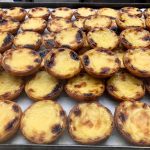The Portuguese love their pastries. There are pastelarias on every street, and they are filled with people day and night stopping in for a sugar fix. The pastry that Lisbon may best be known for is the Pastel de Nata, a two-bite confection of rich, velvety, crème brulee-like custard baked into a light, crispy pastry shell. The iconic egg tart is so popular that there is a competition every year to determine who makes the best pasteis de nata in the city.
The original recipe is believed to date back prior to the 18th Century when the pastries were made by the monks at the Mosteiro dos Jeronimos in Belem, just outside Lisbon. At the time, the monastery used a lot of egg whites to starch the holy robes. In order to not waste the yolks, they were in turn used to make cakes and pastries. The Liberal Revolution of 1820 threatened to close many monasteries in Portugal. So the monks began selling their pastries to support their order. When the monastery was closed in 1834, the monks sold their recipe to a sugar refinery that opened a bakery nearby. The Fabrica de Pasteis de Belem is still selling the pastries today. But their recipe is a closely guarded secret. Our tour guide Marcos from We Hate Tourism Tours told us that the original recipe has been handed down from generation to generation, that only three people know the secret recipe, and they aren’t permitted to travel together!
READ MORE


 Lisbon, Portugal
Lisbon, Portugal 





Recent Comments